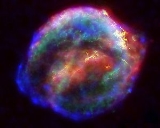
Supernova
Overview
Star
A star is a massive, luminous sphere of plasma held together by gravity. At the end of its lifetime, a star can also contain a proportion of degenerate matter. The nearest star to Earth is the Sun, which is the source of most of the energy on Earth...
explosion that is more energetic
Energy
In physics, energy is an indirectly observed quantity. It is often understood as the ability a physical system has to do work on other physical systems...
than a nova
Nova
A nova is a cataclysmic nuclear explosion in a star caused by the accretion of hydrogen on to the surface of a white dwarf star, which ignites and starts nuclear fusion in a runaway manner...
. It is pronounced icon with the plural supernovae ˌ or supernovas. Supernovae are extremely luminous
Luminous
Luminous may refer to:* Luminous , the sixth release from American Futurepop band Cesium 137* Luminous , a 1998 short story collection by Greg Egan* Luminous, LLC, a contact lens company with headquarters in Portland, Oregon...
and cause a burst of radiation
Radiation
In physics, radiation is a process in which energetic particles or energetic waves travel through a medium or space. There are two distinct types of radiation; ionizing and non-ionizing...
that often briefly outshines an entire galaxy
Galaxy
A galaxy is a massive, gravitationally bound system that consists of stars and stellar remnants, an interstellar medium of gas and dust, and an important but poorly understood component tentatively dubbed dark matter. The word galaxy is derived from the Greek galaxias , literally "milky", a...
, before fading from view over several weeks or months. During this short interval a supernova can radiate as much energy as the Sun
Sun
The Sun is the star at the center of the Solar System. It is almost perfectly spherical and consists of hot plasma interwoven with magnetic fields...
is expected to emit over its entire life span.

